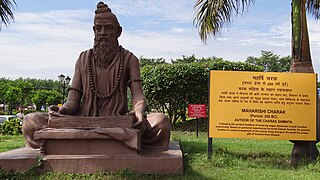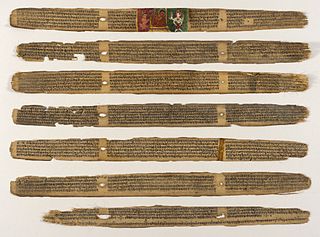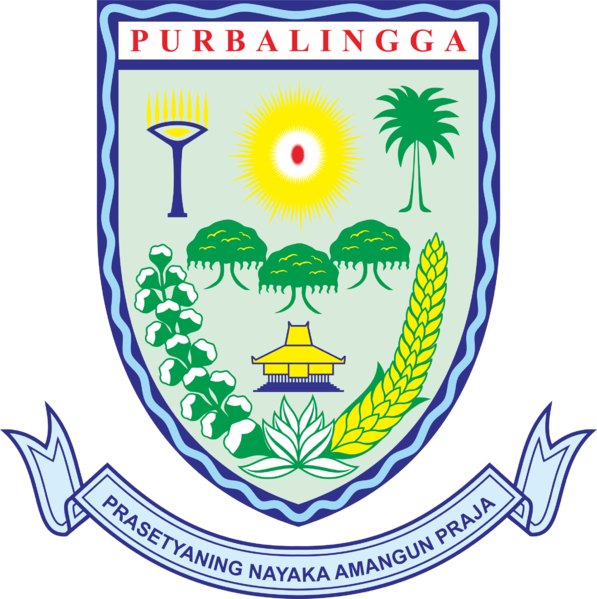
Charaka (चरक) was one of the principal contributors to Ayurveda, a system of medicine and lifestyle developed in Ancient India. He is known for authoring the medical treatise, the Charaka Samhita. Charaka was resident of Kapisthal, located between Iravati and Chandrabagha rivers in Panchanada (Punjab). Panchanada was name of Punjab in Mahabharata. He is well known as the "Indian father of medicine". Charaka is said to have studied at the University of Ancient Taxila and practiced there.
Siddhānta, a Sanskrit term denoting the established and accepted view of any particular school within Indian philosophy. Literally "settled opinion or doctrine, dogma, axiom, received or admitted truth; any fixed or established or canonical text-book on any subject".
The Atharva Veda is the "knowledge storehouse of atharvāṇas, the procedures for everyday life". The text is the fourth Veda, but has been a late addition to the Vedic scriptures of Hinduism.
A shakha, is a Hindu theological school that specializes in learning certain Vedic texts, or else the traditional texts followed by such a school. An individual follower of a particular school or recension is called a śākhin. The term is also used in Hindu philosophy to refer to an adherent of a particular orthodox system.
Agnivesha is a legendary rishi (sage), reputedly one of the earliest authors on ayurveda. He was a pupil of Punarvasu Atreya. The Agnivesh tantra, based on Atreya's teachings is a lost text on Ayurveda, and was the foundational text of the Agnivesha school, i.e., one of the six schools of early Ayurveda.

According to Hindu mythology, Apasmāra was a dwarf who represented ignorance and epilepsy. He is also known as Muyalaka or Muyalakan. In order to preserve knowledge in the world, Apasmāra could not be killed; to do so would throw out the balance of knowledge and ignorance, as to kill Apasmāra would mean attaining knowledge without effort, dedication and hard work. Consequently, this would lead to the devaluing of knowledge in all forms. In order to subdue Apasmāra, Lord Śiva adopted the form of Śrī Naṭarāja - the Lord of Dance and performed the cosmic dance of Tāṇḍava. During this dance, Śrī Naṭarāja suppressed Apasmāra by crushing him with his right foot. As Apasmāra is one of the few demons destined to immortality, it is believed that Lord Śiva forever remains in his Śrī Naṭarāja form suppressing Apasmāra for all eternity.
The Charaka Saṃhitā or Compendium of Charaka is a Sanskrit text on Ayurveda. Along with the Suśruta-saṃhitā, it is one of the two foundational Hindu texts of this field that have survived from ancient India.

The Sushruta Samhita is an ancient Sanskrit text on medicine and surgery, and one of the most important such treatises on this subject to survive from the ancient world. The Compendium of Suśruta is one of the foundational texts of Ayurveda, alongside the Caraka-Saṃhitā, the Bheḷa-Saṃhitā, and the medical portions of the Bower Manuscript. It is one of the two foundational Hindu texts on medical profession that have survived from ancient India.

Tambora is a subdistrict of West Jakarta, Indonesia. Tambora Subdistrict is bounded by a railway to the west and to the north, Kali Krukut - Kali Besar canal to the east, and Duri Selatan Road to the south.

Purbalingga Regency is a regency in the southwestern part of Central Java province in Indonesia. Purbalingga Regency has an area of 677.55 km² and population of 848,952 at the 2010 Census; the latest official estimate is 859,364. The administrative capital is the town of Purbalingga.

The Luso-Sundanese padrão is a stone pillar commemorating a treaty between the kingdoms of Portugal and Sunda, better known as the Luso-Sundanese Treaty of Sunda Kalapa.

KingdomofGaluh was an ancient Hindu kingdom located in the eastern part of Tatar Pasundan, present-day Indonesia. It was established following the end of the Tarumanagara kingdom around the 7th century. Traditionally the kingdom was associated with Eastern Priangan cultural region, around the Citanduy and Cimanuk rivers, with territory spanned from Citarum river on the west, Pamali and Serayu river on the east. Its capital was first located in Karangkamulyan, Ciamis Regency, then Saunggalah, Kuningan, and Kawali, near today Ciamis City. The etymology of "galuh" is Old Sundanese and Old Javanese word for "gemstone".
The Portuguese were the first Europeans to establish a colonial presence in the East Indies. Their quest to dominate the source of the lucrative spice trade in the early 16th century through the Portuguese East India Company, and their simultaneous Roman Catholic missionary efforts, saw the establishment of trading posts and forts, and a Portuguese cultural element that remains in modern-day Indonesia, although not nearly as strong as in neighbouring East Timor.
The ASEAN Way is the official anthem of the Association of Southeast Asian Nations. The lyrics were written by Payom Valaiphatchra and the music composed by Kittikhun Sodprasert and Sampow Triudom, the winning entry out of 99 finalists from all ten ASEAN countries.
The Buni culture is a prehistoric clay pottery culture that flourished in coastal northern West Java, Jakarta and Banten around 400 BC to 100 AD and probably survived until 500 AD. The culture was named after its first discovered archaeological site, Buni village in Babelan, Bekasi, east of Jakarta.
PT Sigma Cipta Caraka or telkomsigma, or just Sigma, is an Indonesian-based information and communications technology business solution provider. Telkomsigma is a wholly owned subsidiary of Telkom Indonesia through its investment subsidiary Multimedia Nusantara, and parts of the Telkom Group. Telkomsigma offers various IT based services, starting from consulting services, software products, software enhanced services and data center operations.

Indonesia–Portugal relations are foreign bilateral relations between Indonesia and Portugal. Portuguese explorer and trader first reached Indonesian archipelago during the age of exploration in the 16th century in order to search for spices in the Indies.
Sumedang Larang was an Islamic Kingdom in western Java. Its territories consisted the Parahyangan region, before it became a vassal state under the Mataram Sultanate.
Mitahara literally means the habit of moderate food. Mitahara is also a concept in Indian philosophy, particularly Yoga, that integrates awareness about food, drink, balanced diet and consumption habits and its effect on one’s body and mind. It is one of the ten yamas in ancient Indian texts.










